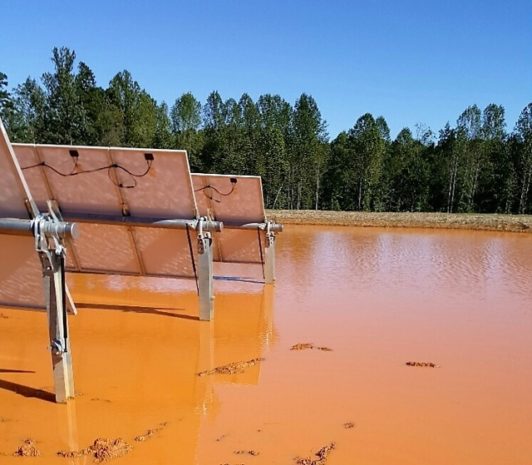The latest tracker design by the Fremont, California-based subsidiary of Flex, the NX Horizon can withstand winds in the 100 – 130mph range, as well as a three second gust per ASCE7-10, and the design is configurable for higher wind speeds. Among design elements that help the unit withstand high winds is a torsional limiter. Included at each foundation/bearing for additional wind and snow load protection, the company notes.
For the NEXTracker wind test, Fort Collins, Colorado-based CPP created a 1:30 scale model of a representative field of NX tracker rows, featuring nearly 1,000 pressure taps to measure wind pressures at key locations along each row. Then CPP technicians put the model through its paces in the wind tunnel, measuring pressures at every tap for a variety of module inclinations and all wind approach directions.
CPP capabilities include 3 recirculating boundary-layer wind tunnels, the newest of which is a vertical recirculating tunnel in Sydney. The company also performs on-site model design and fabrication facilities, including a 3D printer for test models, to produce even the most complex models efficiently and accurately. “We have a full-scale field site where we conduct prototype and full-scale model testing. Like our wind tunnels, the field site includes a turntable that allows us to observe the effects of winds from many angles, as they happen,” CPP indicates. “We also have an industrial-level multiple-CPU computer cluster for CFD, mesoscale, and other computer simulations. This computing resource provides faster, more highly resolved solutions,” the company concludes.
“In a study like this, data collection is the easy part. But making sense of the large data sets that result takes experience, intuition, and a nuanced understanding of the wind patterns that develop in and around fields of solar collectors. Using specialized software that CPP’s solar team developed just for these kinds of studies, they put together the individual pieces to create a comprehensive picture of how our tracking system would behave under a wide range of configurations and wind conditions,” NEXTracker points out.
“Wind tunnel data was then used to predict how vibration would affect loads along the rotational axes. CPP offered recommendations on how we could account for these dynamic effects, thus providing greater value to our customers. Thanks to CPP and other 3rd party testing organizations, the solar industry is increasingly recognizing that specialized approaches like wind tunnel testing are needed for dynamic wind loading because building codes simply don’t apply to these kinds of thin, flexible structures,” NEXTracker adds.
CPP also tests roof-top solar installations for wind resistance. “CPP continues to lead the evolution of roof-mounted solar with, WindLab-Solar, the online wind load calculator customized for your commercial-scale rooftop solar product. Using the results of your system-specific wind tunnel study, WindLab-Solar calculates the loads on every panel in your installation, providing easy access to critical data for successful solar project. CPP delivers the critical information you need to give you a competitive edge in the dynamic solar power industry,” the company suggests.
This content is protected by copyright and may not be reused. If you want to cooperate with us and would like to reuse some of our content, please contact: editors@pv-magazine.com.









By submitting this form you agree to pv magazine using your data for the purposes of publishing your comment.
Your personal data will only be disclosed or otherwise transmitted to third parties for the purposes of spam filtering or if this is necessary for technical maintenance of the website. Any other transfer to third parties will not take place unless this is justified on the basis of applicable data protection regulations or if pv magazine is legally obliged to do so.
You may revoke this consent at any time with effect for the future, in which case your personal data will be deleted immediately. Otherwise, your data will be deleted if pv magazine has processed your request or the purpose of data storage is fulfilled.
Further information on data privacy can be found in our Data Protection Policy.